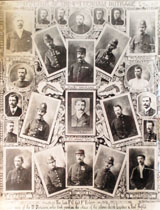Introduction
Most people associate policing with fighting crime. Stories about policing and crime have always been popular in the news media as well as with novelists, playwrights and film makers. But these crime stories tend to be sensational. They focus on violent offences - stabbing, shooting, murder, rape - and on the behaviour of gangs. In fact most criminal offending is (and always was) petty and usually involved the theft of small items or minor acts of vandalism.
Up until the end of the eighteenth century crime was associated with acts of personal depravity. Explosive economic and demographic growth and resultant urban changes in early nineteenth-century Britain led contemporaries to view 'change' as a social force in its own terms. Linked with notions of 'change' were fears about the collapse of 'traditional values' such as the break-up of extended families as society moved from a rural to urban base, and the sinister spectre of the 'poor'. The criminal, especially the offender drawn from the poorest section of the working class, symbolized these changes. Alongside these social dislocations was the advent of the collection of various forms of economic and social statistics. Criminal statistics began to be collected for England and Wales from 1810, but the first figures collected went back to 1805.
Objectives
The aim of this module is to help you to:
- Appreciate the complexities involved in defining crime.
- Understand the processes that lead police officers to target certain forms of crime.
- Evaluate the factors that determined the relationship between official statistics and the reality of crime.
 Souvenir of the Tottenham outrage
Souvenir of the Tottenham outrage